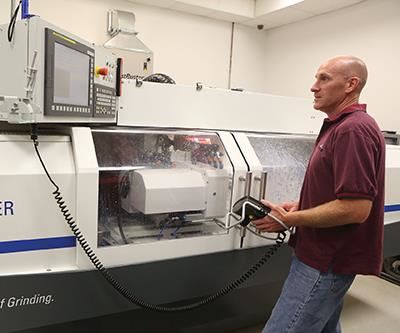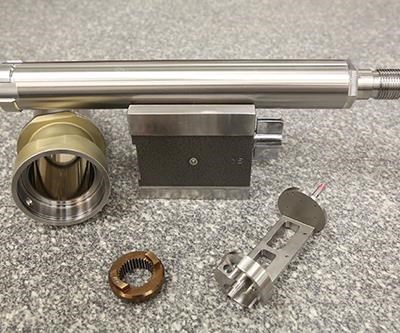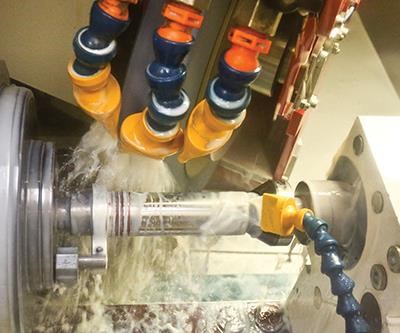Shop Transitions to Aerospace Work with CNC Grinder
J&E Precision Tool met increased demand for complex, high-precision parts with the Studer S33 grinder from United Grinding, leading to improved workflow, part quality, machine utilization and quoting.
Share




“Anybody can make the easy stuff,” says Jon Labrie, general manager of J&E Precision Tool Inc. That reality doesn’t reflect the high-precision work the Southampton, Massachusetts, shop now does, but that wasn’t always the case. The shop began in a one-stall garage, providing general commercial machining services including toolmaking, and production of firearm parts and fixtures. Over the years, the company began taking on higher-precision work, specifically in the aerospace and defense industry sector. As demand increased for even more complex and higher-precision parts, J&E invested in advanced manufacturing systems, including a CNC grinder from United Grinding, and realized a wide range of positive effects on workflow and delivery, part quality, machine utilization, production costs, and quoting.
At any given time, J&E can process 100 jobs simultaneously. It produces microscopic parts—running end mills measuring just under 0.0008 inch in diameter and drilling holes to 0.005 inch in diameter, for example—but, at the same time, it also machines parts as large as 20 by 60 by 18 inches. Job lot sizes range from one to upwards of 2,500 pieces.
All this is done in the company’s current 45,000-square-foot facility, which it moved to in 2001, by its 70 employees. It operates a broad selection of CNC equipment, including three-, four- and five-axis milling machines; 10 lathes; and a seven-axis turn-mill. The company serves customers across the United States in not only the aerospace and defense markets, but also in the microwave equipment industry—a niche market that has been growing like wildfire for the shop, Mr. Labrie says.
However, with new markets and customers came the demand for increasingly complex and higher-precision parts. From its work on aerospace and defense projects, J&E was familiar with machining high-performance materials such as stainless steels, titanium, nickel-based alloys and aluminum, but what really took the shop to the next level, Mr. Labrie says, was grinding those materials.
With customer needs in mind, J&E decided to add advanced CNC grinding capability to its shop floor. Previously, grinding capability was limited to outer diameter, inner diameter and flat grinding, and some lapping on machines that were “old relics,” Mr. Labrie says. Unable to take on production grinding, the company had to subcontract this work. However, issues with cost and scheduling constantly arose.
“We manufacture parts from beginning to end, from raw stock to finished parts. We could no longer depend on someone else to grind parts to the schedule we needed,” he says. “We were at the mercy of our supplier. He did a fantastic job, but had many other customers also vying for his time. This is when we acquired a CNC grinder. It eliminated a lot of those problems.”
After researching available grinding technology, J&E purchased a Studer S33 universal cylindrical grinder from United Grinding (Miamisburg, Ohio) in 2013. Mr. Labrie says United Grinding helped his company get up to speed quickly with the new machine. “They came into our facility and trained us for a week,” he says. “Then, after we ran the machine for a while, they came back for another week once we knew more about
what we were doing and had more questions.”
When grinding exotic materials, choices of wheel types, speeds and feeds, and cutting fluids can make a significant difference in final part dimensions and quality, he explains. The shop occasionally resorts to trial and error to find optimal grinding parameters, but the grinding knowledge and experience of personnel usually produces the best combinations of tooling and parameters. The machine’s operators also program the shop’s grinding processes.
The S33 processes medium-size workpieces both individually and in batches, and it features one ID wheel and two OD wheels. Its wheelhead has two motor spindles for external grinding as well as an internal grinding attachment, which enables the company to grind complex workpieces in a single clamping.
Creating effective grinding setups can be a challenge, Mr. Labrie says, because they occasionally involve “crazy stuff and other unique fixtures” to hold parts that are not round or simple to clamp. “With tight tolerances, you don’t want to squeeze a thin-walled part out of round, push the process too hard, or add stresses during grinding,” he says. “And fixturing is often the determining factor of whether a part is acceptable once grinding is complete.”
The S33 grinder has enhanced the shop’s ability to maintain top part quality, he says. Previously, some parts were both roughed and finished on turning centers. Now, many of those same parts are roughed on a turning center and finished on the grinder. Along with improving part quality, this enables the company to improve production time on these parts. Plus, replacing turning with grinding frees up its turning centers to process other parts, Mr. Labrie says.
Another benefit of the Studer grinder is that J&E has regained full control of its grinding process. It can now take on jobs it would’ve had to turn down in the past. Also, Mr. Labrie can now decide to put two shifts on a part or run it over the weekend to help ensure on-time delivery.
Grinding parts in-house instead of subcontracting the work positively affects the quoting process as well. Mr. Labrie says that quotes previously took into account the subcontractor’s grinding charge, which included that subcontractor’s overhead costs and profit margin. Now, those outside costs are eliminated, and J&E can offer customers more competitive pricing.
Adding flexible CNC grinding technology has affected nearly every aspect of J&E’s production process. Grinding capability and process control have facilitated the addition of new markets and customers, higher part quality, reliable delivery times, and lower costs. Mr. Labrie expects the progress to continue: “We never stop looking forward,” he says.
Related Content
Where Micro-Laser Machining Is the Focus
A company that was once a consulting firm has become a successful micro-laser machine shop producing complex parts and features that most traditional CNC shops cannot machine.
Read MoreInside a CNC-Machined Gothic Monastery in Wyoming
An inside look into the Carmelite Monks of Wyoming, who are combining centuries-old Gothic architectural principles with modern CNC machining to build a monastery in the mountains of Wyoming.
Read MoreQuick-Change Tool Heads Reduce Setup on Swiss-Type Turning Centers
This new quick-change tooling system enables shops to get more production from their Swiss turning centers through reduced tool setup time and matches the performance of a solid tool.
Read MoreLean Approach to Automated Machine Tending Delivers Quicker Paths to Success
Almost any shop can automate at least some of its production, even in low-volume, high-mix applications. The key to getting started is finding the simplest solutions that fit your requirements. It helps to work with an automation partner that understands your needs.
Read MoreRead Next
Building Out a Foundation for Student Machinists
Autodesk and Haas have teamed up to produce an introductory course for students that covers the basics of CAD, CAM and CNC while providing them with a portfolio part.
Read More5 Rules of Thumb for Buying CNC Machine Tools
Use these tips to carefully plan your machine tool purchases and to avoid regretting your decision later.
Read MoreRegistration Now Open for the Precision Machining Technology Show (PMTS) 2025
The precision machining industry’s premier event returns to Cleveland, OH, April 1-3.
Read More






















.jpg;maxWidth=300;quality=90)















